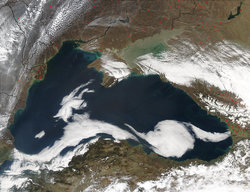Black Sea
|
|
Cities_of_the_Black_Sea.png
The Black Sea (known as the Euxine Sea in antiquity) is an inland sea between southeastern Europe and Asia Minor. It is connected to the Mediterranean Sea by the Bosporus and the Sea of Marmara, and to the Sea of Azov by the Strait of Kerch.
There is a net inflow of seawater through the Bosporus, 200 km³ per year. There is an inflow of freshwater from the surrounding areas, especially central and middle-eastern Europe, totalling 320 km³ per year. The most important river entering the Black Sea is the Danube. The Black Sea has an area of 422,000 km² and a maximum depth of 2210 m.
Countries bordering on the Black Sea are Turkey, Bulgaria, Romania, Ukraine, Russia, Georgia. The Crimea is an Autonomous Republic of Ukraine.
Important cities along the coast include: Istanbul (formerly Constantinople and Byzantium), Burgas, Varna, Constanţa, Yalta, Odessa, Sevastopol, Kerch, Novorossiysk, Sochi, Sukhumi, Batumi, Trabzon, Samsun.
| Contents |
Geology
The Black Sea is the largest anoxic, or oxygen-free, marine system. This is a result of the great depth of the sea and the relatively high salinity (and therefore density) of the water at depth; freshwater and seawater mixing is limited to the uppermost 100 to 150 m, with the water below this interface (called the pycnocline) being exchanged only once every thousand years. There is therefore no significant gas exchange with the surface, and as a result decaying organic matter in the sediment consumes any available oxygen. In these anoxic conditions some extremophile microorganisms are able to use sulfate (SO42−) for oxidation of organic material, producing hydrogen sulfide (H2S) and carbon dioxide. This mix is extremely toxic (a lungful would be fatal to a human), resulting in a sea that has almost all of its ecology living in that top layer down to a depth of approximately 180 m (600 ft). The relative lack of micro-organisms and oxygen has allowed deep-sea expeditions to recover ancient (on the order of thousands of years) human artifacts, such as boat hulls and the remains of settlements.
Large amounts of organic material reach the bottom of the sea and accumulate in the sediments in concentrations of up to 20%. These kinds of sediments are called sapropel.
While it is agreed that the Black Sea has been a sweetwater lake (at least in upper layers) with a considerably lower level during the last glaciation, its postglacial development into a marine sea is still a subject of intensive study and debate. There are catastrophic scenarios such as put forward by William Ryan and Walter Pitman as well as models emphasizing a more gradual transition to saline conditions and transgression in the Black Sea. They are based on different theories about the level the sweetwater lake had reached by the time the Mediterranean Sea was high enough to flow over the Dardanelles and the Bosphorus. On the other hand, a study of the sea floor on the Aegean side shows that in the 8th millennium BCE there was a large flow of fresh water out of the Black Sea (New Scientist, 4 May 2002, p. 13).
Ryan-Pitman Deluge Theory
For more detail, see the main article at Black Sea deluge theory.
In 1997, William Ryan and Walter Pitman from Columbia University published a theory that a massive flood through the Bosporus occurred about 5600 BC. They claim that the Black and Caspian Seas were vast freshwater lakes, into which the Mediterranean spilled over a rocky sill at the Bosphorus. Subsequent work has been done to both support and discredit this theory, and it remains an active subject of debate among archaeologists.
History
The steppes to the north of the Black Sea suggested as the original homeland (Urheimat) of the speakers of the Proto-Indo-European language, (PIE) the progenitor of the Indo-European language family, by some scholars (see Kurgan; others move the heartland further east towards the Caspian Sea, yet others to Anatolia).
The name 'Black Sea' (initially Pontos Axeinos, "inhospitable sea", later renamed Pontos Euxeinos, "hospitable sea" to gain the sea's good favor) was coined by the Ancient Greek navigators, because of the unusual dark color, compared with the Mediterranean Sea. Visibility in the Black Sea is on average approximately 5 metres (15 feet), as compared to up to 35 metres (100 feet) in the Mediterranean. The land at the eastern end of the Black Sea, Colchis (now Georgia), marked for the Greeks an edge of the known world.
Holiday resorts and spas
Sochi.jpg
- Sochi
- Anapa
- Yalta
- Mamaia
- Olimp
- Neptun
- Jupiter
- Venus
- Saturn
- Mangalia
- Vama Veche
- Rusalka
- Balchik
- Albena
- Golden sands
- St. Konstantin
- Kamchia
- Emona
- Sveti Vlas
- Sunny Beach
- Nessebar
- Pomorie
- Chernomorets
- Sozopol
- Diuni
- Primorsko
- Tsarevo
- Trinaso
See also
Anoxic event
Bulgarian Black Sea Coast
External references
- Charles King, The Black Sea: A History, 2004, ISBN 0199241619
- William Ryan and Walter Pitman, Noah's Flood, 1999, ISBN 0684859203
- Neal Ascherson, Black Sea (Vintage 1996), ISBN 0099593718
- Öztürk, Özhan. Karadeniz: Ansiklopedik Sözlük (Blacksea: Encyclopedic Ditionary). 2 Cilt (2 Volumes). Heyamola Publishing. Istanbul.2005
External links
- The Black Sea Trade Project (http://www.museum.upenn.edu/Sinop/SinopIntro.htm)
- http://www.blacksea-archaeology.org/ast:Mar Prieta
bg:Черно море ca:Mar Negra cs:Černé moře cy:Y Môr Du da:Sortehavet de:Schwarzes Meer et:Must meri es:Mar Negro eo:Nigra Maro fr:Mer Noire it:Mar Nero he:הים השחור lt:Juodoji jūra nl:Zwarte Zee ja:黒海 no:Svartehavet pl:Morze Czarne pt:Mar Negro ro:Marea Neagră ru:Чёрное море scn:Mari Niuru sk:Čierne more sl:Črno morje fi:Mustameri sv:Svarta havet tr:Karadeniz uk:Чорне море zh:黑海


